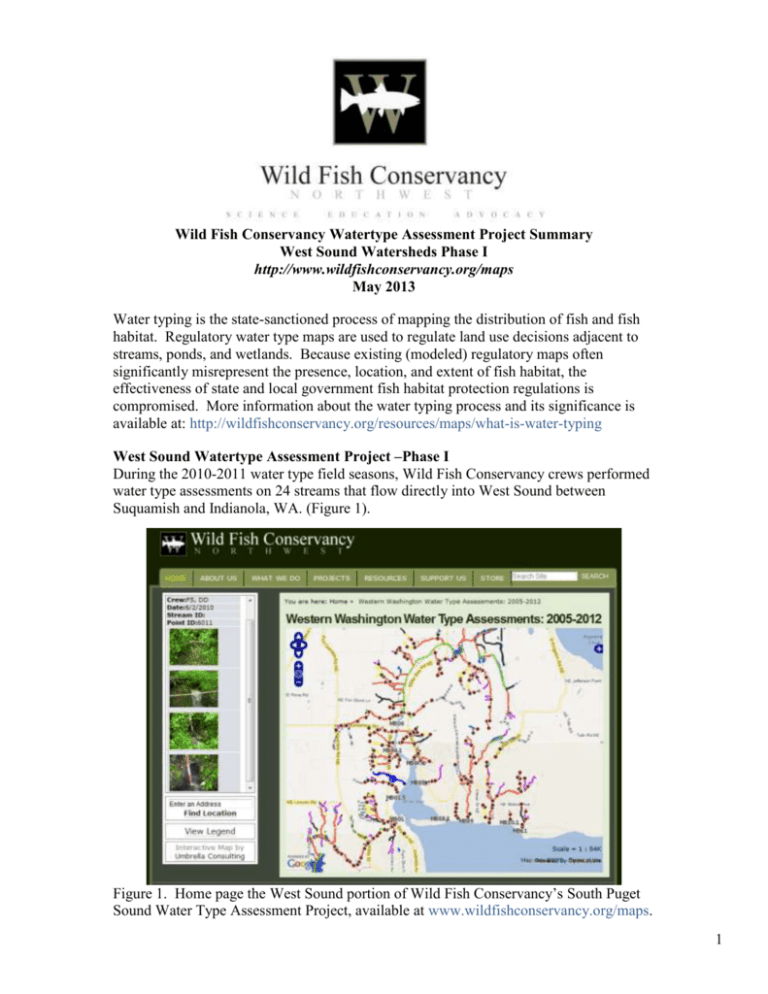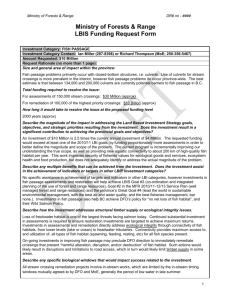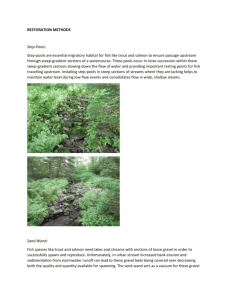Westsound Phase I Closeout
advertisement

Wild Fish Conservancy Watertype Assessment Project Summary West Sound Watersheds Phase I http://www.wildfishconservancy.org/maps May 2013 Water typing is the state-sanctioned process of mapping the distribution of fish and fish habitat. Regulatory water type maps are used to regulate land use decisions adjacent to streams, ponds, and wetlands. Because existing (modeled) regulatory maps often significantly misrepresent the presence, location, and extent of fish habitat, the effectiveness of state and local government fish habitat protection regulations is compromised. More information about the water typing process and its significance is available at: http://wildfishconservancy.org/resources/maps/what-is-water-typing West Sound Watertype Assessment Project –Phase I During the 2010-2011 water type field seasons, Wild Fish Conservancy crews performed water type assessments on 24 streams that flow directly into West Sound between Suquamish and Indianola, WA. (Figure 1). Figure 1. Home page the West Sound portion of Wild Fish Conservancy’s South Puget Sound Water Type Assessment Project, available at www.wildfishconservancy.org/maps. 1 This water type assessment encompassed 61 miles of streams draining into and adjacent to Miller Bay in N. Kitsap County (Figure 2). WFC conducted water type surveys using the protocols and definitions provided in WAC 222-16-031 and Section 13 of the Forest Practices Board Manual. WFC collected data only on properties where permission to do so was granted. During this phase of the project WFC requested permission from 983 property owners. Of these, 288 (30 percent) granted permission for the WFC staff to perform the survey on their property. WFC documented stream channel location and characteristics, fauna, riparian condition, and restoration opportunities via GPS and photographs. Wetted width, bankfull width, channel gradient, and other data were recorded at each GPS point and are visible, with photographs, by clicking on the points in the interactive map. We present more than 1,050 photographs (with associated channel condition descriptions) on the interactive web-based GIS. Fauna encountered during the surveys included cutthroat trout, possible rainbow trout, coho salmon, chum salmon, sculpin, brook lamprey, 3-spined stickleback, signal crayfish, red-legged frogs, western red-backed salamanders (Figure 3). Non-native species encountered included Pumpkinseed sunfish and bullfrogs. Habitat features and fauna were documented via GPS and photographs that are viewable in the interactive GIS. 2 Figure 2. Geographic extent of WFC’s West Sound Watersheds Assessment - Phase 1 in NE Kitsap County. The red dots represent the mouths of the surveyed basins. As expected based on previous Wild Fish Conservancy water type assessments, significant discrepancies existed between the Washington Department of Natural Resources (WDNR) regulatory maps and what we found on the ground. For example, over the study area WDNR had identified 39 miles of streams. WFC found that 6.2 miles of those WDNR mapped channels did not exist, but that an additional 24.1 miles of stream channels did exist that were not on the official WDNR water type maps. Restoration Opportunities During the course of the field surveys, Wild Fish Conservancy staff observed and documented habitat restoration and protection opportunities; these are presented in Appendix A. This prioritized list of opportunities was presented to the West Sound Watersheds Technical Advisory Group at a Lead Entity meeting during winter 2013; WFC is coordinating with potential project sponsors to develop restoration and protection projects based on these observations. Initial WFC prioritization of the projects was based on the area and quality of habitat affected, and the number and ESA-status of species likely to be impacted. Discussion with the Lead Entity Technical Advisory Group led to the final prioritization (Appendix A) and included consideration of benefit (high priority habitat 3 features or processes, high priority geographic area, species affected, life history stage affected, reasonable cost per gain) and certainty (project is consistent with scientific methods, appropriate sequencing, addresses a high potential threat, and likelihood of willing landowners). Figure 3. Juvenile coho salmon captured in Cowling Creek downstream from several barrier culverts. The West Sound Watertype Assessment is described on Wild Fish Conservancy’s web site at: http://wildfishconservancy.org/projects/west-sound-watertype-assessment In 2010, WFC presented assessment preliminary findings and implications at the Friends of Miller Bay annual meeting – that presentation is on WFC’s web site at: http://wildfishconservancy.org/what-we-do/science/ecosystem-preservation/watertyping/west-sound-watersheds-water-type-assessment-presentation/view WFC’s Water Type Assessment project is ongoing; in 2013 Wild Fish Conservancy crews will be performing field surveys in additional Puget Sound drainages in Kitsap County (WRIA 15), the Chehalis Basin (WRIA 22-23), and other regions of the state. Funding for this project was provided by the Salmon Recovery Funding Board and Kitsap County. Wild Fish Conservancy would also like to acknowledge the support and assistance provided to this project by the West Sound Lead Entity process, including but not limited to the Suquamish Tribe, Kitsap County, and WDFW. 4 Appendix A. Restoration and Protection Opportunities observed during WFC’s West Sound Watertype Assessment Project –Phase I Project ID Priority Stream GPS point A high MB01 wpt 517 B high MB01 wpt 563 C high MB01A D high MB10 E high MB06A F G H med med med MB06D.1 MB02 MB02 I med MB02 J med MB02 K med MB07 comments This point has a control structure and holding ponds used by the Suquamish tribe to rear Dam and control structure Improve fish passage Chum Salmon. Improving fish passage through this facility would open up prime habitat for Chum Salmon rearing past hatchery facility at to one of the largest basins in Miller Bay and would benefit Chum, Coho, Steelhead and ponds Cowling Cr preserve Cutthroat Trout. This culvert is a significant barrier to fish passage. The upstream habitat is forest land Barrier culvert with ~3ft Restore fish passage and wetlands that would provide ideal anadromous rearing habitat to Chum,Coho, outfall on Columbia St NE through the culvert Steelhead and Cutthroat Trout. problem/opportunity potential solution wpt 500 Trail crossing and weir that is a partial barrier to fish passage. Remove the weir and repair the channel man 016 Old check dam and ruins Remove ruins and check of a water supply and dam and repair the partial barrier culvert culvert to improve fish crossing on NE Shore passage. Drive This weir is at a trail crossing in the Cowling Cr Natural Preserve. It appears to be a diversion for a water supply and is no longer in use. This easy fix would improve anadromous fish pasage for Chum,Coho,Steelhead and Cutthroat Trout. This crossing on MB10 (Indianola Cr) is a partial barrier. On site is a check dam and the ruins to a water supply (~30ft downstream of the outlet) that is no longer in use and is a barrier to fish passage. Restoring passage through this site would open up several thousand feet of andromous fish habitat to Chum, Coho, Steelhead and Cutthroat Trout. This site has two stock pond dams, a driveway, and abandoned road culvert. Wpt 063 Wpt Two barrier dams and an Improve and restore fish and 064 are dams and wpt 065 is a back to back driveway and abandoned road. Great 063,064,065 abandoned road crossing. passage to upper valley rearing and upstream habitat if the stream were reopened - a three in one project. This crossing is a private access road at A & L Topsoil. The channel ~50ft downstream of replace and repair the the culvert disperses into a peat bog wetland. The channel is bordered with piles of bark culvert and riparian and dirt. The wetland was mined for peat moss in the past and there is an open water corridor pond >1 acre within the wetland and floodplain of Grovers Cr. Upstream the channel drains Pope lands in a natural forested ravine. man 023 Partial barrier culvert and deforested riparian corridor man 001 Repair barrier culverts Two barrier culverts and a and dam to improve fish dam that are back to back, passage and make all are total barriers to fish improvements to the passage riparian corridor. wpt 216 Culvert barrier This property has three of six fish passage barriers up to and including Miller Bay Road. On site there is a diversion, a private drive culvert, and a check dam that makes a small reservoir that was used for irrigation. All three are total barriers to fish passage. The land owner said he still has water rights but did not use the dam reservoir at the time of the survey. There is more than 2000ft of fish habitat upstream of the barriers. Repair barrier culvert to improve fish passage This culvert crossing is on a private drive access road and is the fourth of six man-made and make improvements barriers on MB02 up to Miller Bay Road. to the riparian corridor. Private drive culvert with Repair culvert and This culvert is on a private drive, it is the fifth of six man-made barriers on MB02. This a catch basin at the outlet remove old water supply wpt 222 culvert has a 2ft drop into a catch basin that was used as a water supply for irrigation in that was used as a water catch basin to improve the past but is no longer in use. supply. fish passage. This culvert crossing on Miller Bay Road is the upper most of six man-made barriers on Repair barrier culvert to wpt 223 Culvert barrier MB02 up to Miller Bay Road. Restoring MB02 would gain access to more than 2000ft of improve fish passage. andromous fish habitat in the Miller Bay basin. These are three back to back landscape ponds and a private drive crossing. We did not Three barrier dams and a Wpt Improve and restore fish gain access to determine the upper extent of the channel but upstream of Indianola Rd private drive road 118,119,120 passage to upper valley the channel splits and has a good spring influence, with channels that meet criteria for F crossing. stream type. 5 Map and photos for Project ID “A.” The blue dot represents the project location. Additional details are available on the interactive map site at: www.wildfishconservancy.org 6 Map and photos for Project ID “B.” The blue dot represents the project location. Additional details are available on the interactive map site at: www.wildfishconservancy.org 7 Map and photos for Project ID “C.” The blue dot represents the project location. Additional details are available on the interactive map site at: www.wildfishconservancy.org 8 Map and photos for Project ID “D.” The blue dot represents the project location. Additional details are available on the interactive map site at: www.wildfishconservancy.org 9 Map and photos for Project ID “E.” The blue box represents the project location. Additional details are available on the interactive map site at: www.wildfishconservancy.org 10








